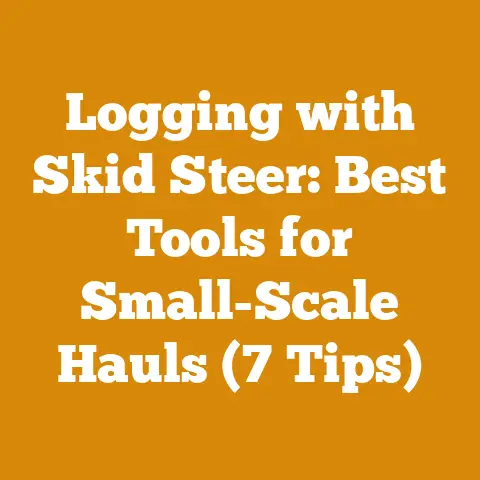325 vs 3 8 Chain Guide (5 Expert Tips for Optimal Cutting)
.325 vs. 3/8 Chain Guide: 5 Expert Tips for Optimal Cutting
In an era where sustainability is no longer a buzzword but a necessity, the responsible management of our forests and wood resources has never been more crucial. From the choice of timber we harvest to the tools we use, every decision has an impact. As someone who has spent years immersed in the world of logging, firewood preparation, and wood processing, I’ve seen firsthand how optimizing your equipment and techniques can not only improve efficiency but also contribute to a more sustainable approach. This article delves into the specifics of chainsaw chains, comparing .325 and 3/8 pitch chains, and provides five expert tips to ensure optimal cutting performance while keeping a close eye on your budget.
Understanding Chainsaw Chain Pitch: .325 vs. 3/8
The pitch of a chainsaw chain refers to the distance between three consecutive rivets divided by two. Essentially, it’s the size of the chain. The two most common pitches are .325 and 3/8. Understanding the differences between them is vital for selecting the right chain for your chainsaw and the type of wood you’re cutting.
-
.325 Pitch Chains: These chains are generally preferred for smaller to medium-sized chainsaws, typically those with engine sizes ranging from 30cc to 50cc. They offer a good balance of cutting speed and efficiency, making them suitable for limbing, pruning, and felling smaller trees.
-
3/8 Pitch Chains: 3/8 chains are typically used on larger, more powerful chainsaws (50cc and above). They are designed for heavier-duty tasks, such as felling large trees and bucking logs. These chains offer more aggressive cutting performance but require more power from the chainsaw.
Choosing the wrong pitch can lead to poor cutting performance, increased wear and tear on your chainsaw, and even potential safety hazards.
Why the Right Chain Matters: Sustainability, Efficiency, and Cost
Selecting the appropriate chain is about more than just cutting wood; it’s about sustainability, efficiency, and, crucially, cost. A poorly chosen chain will require more frequent sharpening and replacement, increasing your expenses and downtime. It will also place unnecessary strain on your chainsaw, shortening its lifespan.
From a sustainability perspective, an inefficient chain wastes energy and can lead to increased emissions. A sharper, more appropriate chain cuts cleaner, reducing the amount of sawdust produced and minimizing waste.
My Personal Experience:
I recall a time when I was working on a firewood preparation project. I initially opted for a 3/8 chain on a smaller chainsaw, thinking that a larger chain would equate to faster cutting. However, the chainsaw struggled to maintain its speed, and the chain dulled quickly. After switching to a .325 chain, the chainsaw performed much better, and I was able to cut through the wood with greater ease and efficiency. This experience highlighted the importance of matching the chain pitch to the chainsaw’s capabilities.
Cost Considerations: A Deep Dive
Let’s face it: in any wood processing or firewood preparation project, the bottom line matters. Understanding the cost implications of your chainsaw chain choice is essential for effective budgeting.
1. Chain Price:
The initial cost of a .325 or 3/8 chain can vary depending on the brand, quality, and length. Generally, 3/8 chains tend to be slightly more expensive due to their larger size and construction.
- .325 Chain: Expect to pay anywhere from $20 to $40 for a standard .325 chain.
- 3/8 Chain: A 3/8 chain will typically cost between $25 and $50.
These are just average prices, and you may find better deals online or at local hardware stores.
2. Sharpening Costs:
Chain sharpening is a regular maintenance task that can significantly impact your overall costs. Dull chains require more force to cut, which can lead to increased fuel consumption and wear and tear on your chainsaw.
- DIY Sharpening: If you sharpen your chains yourself, you’ll need to invest in a sharpening kit, which can cost anywhere from $20 to $100, depending on the quality and features.
- Professional Sharpening: Alternatively, you can have your chains professionally sharpened at a local hardware store or chainsaw shop. This typically costs between $10 and $20 per chain.
The frequency of sharpening will depend on the type of wood you’re cutting and the condition of the chain. Hardwoods, such as oak and maple, will dull chains more quickly than softwoods, such as pine and fir.
3. Chain Replacement Costs:
Even with proper maintenance, chainsaw chains will eventually need to be replaced. The lifespan of a chain depends on several factors, including the quality of the chain, the type of wood you’re cutting, and how well you maintain it.
- Average Lifespan: A well-maintained chain can last anywhere from a few months to a year, depending on usage.
- Replacement Costs: When it’s time to replace your chain, you’ll need to factor in the cost of a new chain, as mentioned above.
4. Fuel Consumption:
An often-overlooked cost factor is fuel consumption. A dull or inappropriate chain will require more power to cut, leading to increased fuel usage.
- Fuel Costs: Fuel costs can vary depending on your location and the type of fuel you use. However, it’s safe to say that fuel consumption can add up over time, especially if you’re using your chainsaw frequently.
5. Chainsaw Maintenance Costs:
Using the wrong chain can put undue stress on your chainsaw, leading to increased maintenance costs. This can include repairs to the engine, bar, and other components.
- Maintenance Costs: Chainsaw maintenance costs can vary depending on the severity of the problem. However, regular maintenance, such as cleaning the air filter and checking the spark plug, can help prevent costly repairs down the road.
Data-Backed Insights:
According to a study by the U.S. Forest Service, proper chainsaw maintenance, including chain sharpening and replacement, can reduce fuel consumption by up to 20%. This translates to significant cost savings over the long term.
Cost Optimization Tips:
- Choose the Right Chain: Selecting the appropriate chain for your chainsaw and the type of wood you’re cutting is the first step to optimizing costs.
- Sharpen Regularly: Keeping your chain sharp will reduce fuel consumption and wear and tear on your chainsaw.
- Maintain Your Chainsaw: Regular maintenance, such as cleaning the air filter and checking the spark plug, can prevent costly repairs.
- Buy in Bulk: Consider buying chains in bulk to save money on the initial purchase price.
- Shop Around: Compare prices from different retailers to find the best deals on chains and sharpening equipment.
5 Expert Tips for Optimal Cutting
Now that we’ve covered the cost considerations, let’s dive into five expert tips to ensure optimal cutting performance with your .325 or 3/8 chain.
1. Match the Chain to the Saw and Task:
This may seem obvious, but it’s worth reiterating. The most common mistake I see is people using the wrong chain for their chainsaw or the task at hand. As mentioned earlier, .325 chains are best suited for smaller chainsaws and lighter tasks, while 3/8 chains are designed for larger chainsaws and heavier-duty applications.
Before you start cutting, take a moment to assess your chainsaw’s capabilities and the type of wood you’ll be cutting. If you’re unsure which chain is best, consult your chainsaw’s owner’s manual or ask a professional at a local chainsaw shop.
2. Sharpen Your Chain Regularly:
A sharp chain is a safe and efficient chain. A dull chain requires more force to cut, which can lead to kickback and other safety hazards. It also puts unnecessary strain on your chainsaw, shortening its lifespan.
I recommend sharpening your chain every time you refuel your chainsaw. This will ensure that you’re always cutting with a sharp chain, which will improve your efficiency and reduce your risk of injury.
There are several ways to sharpen your chain:
- Hand Filing: This is the most common method, and it involves using a round file and a file guide to sharpen each cutter.
- Electric Sharpener: Electric sharpeners are faster and more precise than hand filing, but they can be more expensive.
- Professional Sharpening: As mentioned earlier, you can have your chains professionally sharpened at a local hardware store or chainsaw shop.
3. Maintain Proper Chain Tension:
Proper chain tension is essential for safe and efficient cutting. A chain that is too loose can derail from the bar, while a chain that is too tight can bind and cause the chainsaw to overheat.
To check the chain tension, lift the chain in the middle of the bar. There should be a small amount of slack, but the chain should not sag. If the chain is too loose or too tight, adjust the tension screw on the side of the chainsaw.
4. Lubricate the Chain and Bar:
Proper lubrication is essential for preventing wear and tear on the chain and bar. The chain should be lubricated with chainsaw bar and chain oil every time you refuel your chainsaw.
To lubricate the chain, fill the oil reservoir with chainsaw bar and chain oil. The chainsaw will automatically lubricate the chain as you cut.
5. Use Proper Cutting Techniques:
Using proper cutting techniques can improve your efficiency and reduce your risk of injury. Here are a few tips:
- Use a Sharp Chain: As mentioned earlier, a sharp chain is essential for safe and efficient cutting.
- Maintain a Steady Grip: Hold the chainsaw firmly with both hands.
- Keep Your Body Balanced: Maintain a stable stance and keep your body balanced.
- Let the Chain Do the Work: Don’t force the chainsaw through the wood. Let the chain do the work.
- Avoid Kickback: Kickback is a sudden, uncontrolled movement of the chainsaw that can cause serious injury. To avoid kickback, avoid cutting with the tip of the bar and be aware of the potential for the chainsaw to kick back if it encounters a knot or other obstruction.
Budgeting for Wood Processing and Firewood Preparation
Now, let’s shift our focus to the broader picture of budgeting for wood processing and firewood preparation. This is where understanding all the cost components comes into play.
1. Timber Purchase or Harvesting Costs:
If you’re purchasing timber, the cost will depend on the species, quality, and volume of wood. Timber prices can vary significantly depending on your location and market conditions.
- Timber Prices: According to the U.S. Forest Service, the average price of standing timber in the United States in 2023 was $45 per thousand board feet (MBF). However, this price can vary significantly depending on the species and location. For example, high-quality hardwood timber, such as oak and walnut, can fetch prices of $100 or more per MBF.
- Harvesting Costs: If you’re harvesting your own timber, you’ll need to factor in the costs of felling, skidding, and loading the logs. These costs can vary depending on the size and location of the trees, as well as the equipment you use.
2. Tool and Equipment Costs:
In addition to the chainsaw, you may need to invest in other tools and equipment, such as a log splitter, wedges, axes, and safety gear.
- Log Splitter: Log splitters can range in price from a few hundred dollars for a manual splitter to several thousand dollars for a hydraulic splitter.
- Wedges and Axes: Wedges and axes are essential for splitting large logs. Expect to pay around $50 to $100 for a good quality axe or wedge.
- Safety Gear: Safety gear, such as a helmet, eye protection, and ear protection, is essential for protecting yourself from injury. Expect to pay around $50 to $100 for a complete set of safety gear.
3. Labor Costs:
If you’re hiring a logging crew or firewood handlers, you’ll need to factor in labor costs. Labor rates can vary depending on your location and the experience of the workers.
- Logging Crew: Logging crew rates can range from $50 to $100 per hour, depending on the size of the crew and the complexity of the job.
- Firewood Handlers: Firewood handler rates can range from $15 to $30 per hour, depending on the experience of the workers.
4. Permits and Fees:
Depending on your location, you may need to obtain permits or pay fees for harvesting timber or selling firewood.
- Harvesting Permits: Harvesting permits can cost anywhere from a few dollars to several hundred dollars, depending on the location and the size of the harvest.
- Firewood Vendor Permits: Firewood vendor permits can cost anywhere from a few dollars to several hundred dollars, depending on the location and the volume of firewood you sell.
5. Transportation Costs:
You’ll need to factor in the cost of transporting the timber or firewood to your processing location or to your customers.
- Fuel Costs: Fuel costs can vary depending on your location and the type of fuel you use.
- Trucking Costs: Trucking costs can range from $1 to $3 per mile, depending on the size of the truck and the distance traveled.
6. Drying Costs:
If you’re selling firewood, you’ll need to factor in the cost of drying the wood. Seasoning firewood properly is crucial for efficient burning and customer satisfaction.
- Drying Time: The drying time for firewood can vary depending on the species of wood and the climate. However, it typically takes at least six months to dry firewood properly.
- Storage Costs: You’ll need to factor in the cost of storing the firewood while it dries. This can include the cost of renting storage space or building a wood shed.
Industry Benchmarks and Statistical Data:
- Average Price per Cord of Firewood: According to the Hearth, Patio & Barbecue Association (HPBA), the average price per cord of firewood in the United States in 2023 was $250. However, this price can vary significantly depending on your location and the species of wood.
- Average Fuelwood Consumption: The average household in the United States that uses wood as a primary heating source consumes approximately 3 cords of firewood per year.
Budgeting Case Study:
Let’s consider a hypothetical case study of a small-scale logger who is planning to harvest timber from a 10-acre woodlot. The logger estimates that the woodlot contains approximately 100 MBF of timber, with an average price of $50 per MBF.
Here’s a breakdown of the logger’s estimated costs:
- Timber Purchase: $5,000 (100 MBF x $50/MBF)
- Harvesting Costs: $2,000
- Tool and Equipment Costs: $1,000
- Labor Costs: $3,000
- Permits and Fees: $500
- Transportation Costs: $1,000
- Total Costs: $12,500
Based on these estimates, the logger would need to sell the timber for at least $125 per MBF to break even.
Cost Optimization Tips for Wood Processing and Firewood Preparation:
- Shop Around for Timber: Compare prices from different timber suppliers to find the best deals.
- Negotiate Labor Rates: Negotiate labor rates with logging crews and firewood handlers.
- Maintain Your Equipment: Regular maintenance can prevent costly repairs.
- Dry Firewood Properly: Seasoning firewood properly can increase its value and reduce drying time.
- Sell Direct to Consumers: Selling firewood directly to consumers can eliminate the middleman and increase your profits.
Relevant Calculations and Formulas
Here are a few relevant calculations and formulas that can be helpful in wood processing and firewood preparation:
- Board Feet Calculation: The formula for calculating the volume of a log in board feet is: (Diameter in inches) x (Diameter in inches) x (Length in feet) / 144.
- Cords Calculation: A cord of firewood is a stack of wood that measures 4 feet high, 4 feet wide, and 8 feet long, or 128 cubic feet.
- Drying Time Estimation: The drying time for firewood can be estimated using the following formula: Drying Time (months) = (Initial Moisture Content – Final Moisture Content) / Drying Rate. The drying rate will vary depending on the species of wood and the climate.
Challenges Faced by Small-Scale Loggers and Firewood Suppliers
Small-scale loggers and firewood suppliers face a number of challenges, including:
- Fluctuating Timber Prices: Timber prices can fluctuate significantly depending on market conditions.
- High Equipment Costs: The cost of chainsaws, log splitters, and other equipment can be prohibitive for small-scale operators.
- Labor Shortages: Finding qualified logging crews and firewood handlers can be difficult.
- Permitting Requirements: Obtaining permits for harvesting timber or selling firewood can be time-consuming and expensive.
- Competition: Small-scale operators face competition from larger logging companies and firewood suppliers.
Visual Elements
Table 1: Cost Comparison of .325 and 3/8 Chains
| Feature | .325 Chain | 3/8 Chain |
|---|---|---|
| Initial Price | \$20-\$40 | \$25-\$50 |
| Sharpening Cost | \$10-\$20 | \$10-\$20 |
| Replacement Cost | \$20-\$40 | \$25-\$50 |
| Fuel Consumption | Lower | Higher |
| Chainsaw Size | Smaller | Larger |
| Task Suitability | Limbing, Pruning | Felling, Bucking |
Table 2: Average Firewood Prices by Region (Example)
| Region | Average Price per Cord |
|---|---|
| Northeast | \$300 |
| Midwest | \$250 |
| South | \$200 |
| West | \$275 |
Note: Prices are approximate and can vary depending on location and wood species.
- Choose the right chain: Match the chain to your chainsaw and the task.
- Maintain your chain: Sharpen regularly, ensure proper tension, and lubricate properly.
- Budget carefully: Account for all cost components, from timber purchase to transportation.
- Optimize your operations: Implement cost-saving measures to improve your profitability.
As someone deeply invested in the world of wood processing, I encourage you to approach your projects with a focus on sustainability, efficiency, and cost-effectiveness. By making informed decisions and implementing best practices, you can not only achieve your goals but also contribute to the responsible management of our precious wood resources.
Next Steps:
- Assess your needs: Determine the type of wood you’ll be cutting and the size of your chainsaw.
- Choose the right chain: Select a .325 or 3/8 chain that is appropriate for your needs.
- Invest in quality sharpening equipment: A good sharpening kit will pay for itself over time.
- Develop a budget: Create a detailed budget that accounts for all cost components.
- Implement cost-saving measures: Look for ways to optimize your operations and reduce your costs.
Remember, the journey of a thousand board feet begins with a single cut. Make it count!






